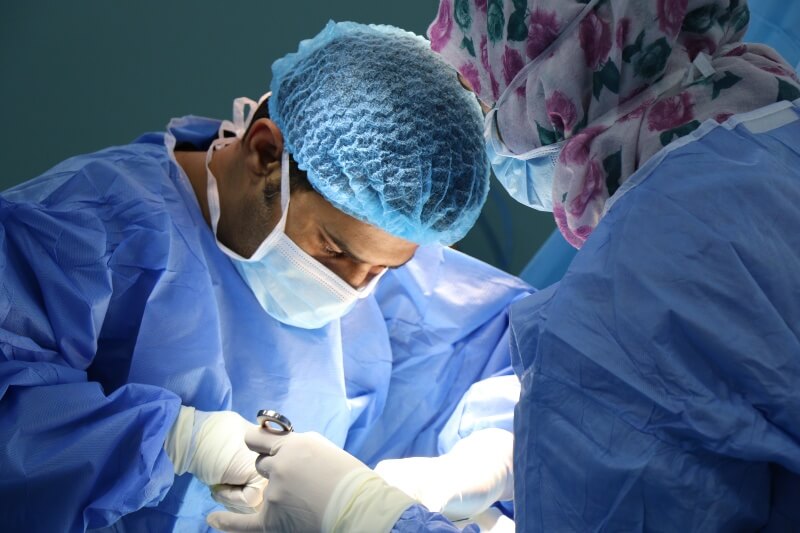
How hard is it to get into medical school?
This is the question that pretty much every premed student wonders at one point or another. We hear it directly from our students all the time!
And we understand why.
There’s a ton of hype, fear, and misinformation being passed around about how hard it is to get into med school. Some say it’s extremely challenging, and others say it’s not as bad as people say.
So which is it?
Here’s the short answer:
Everyone knows that getting into medical school is not a piece of cake. If you’ve been passionate about medicine for quite some time, there’s a good chance that you’ve been told for years that it’s going to require hard work and preparation.
This isn’t anything new. The field has always been highly competitive, accepting only the top students with glowing applications.
But just how hard is it really? That’s what we’re going to explore in this guide. By the time you’re done reading it, you’ll have a better understanding of where you stand and the challenge ahead.
Table of Contents
How Hard Is It Really?
The truth is that getting into medical school has only gotten more difficult in the last decade.
There are several theories as to why this is, which we’ll get into a bit later. When you compare the acceptance figures of the latest pool of matriculants to those from a decade ago, there’s a noticeable change you can’t ignore.
To put this in perspective, let’s take a look at figures published by the AAMC, or Association of American Medical Colleges. According to the data, there has been a significant increase in overall applicants in the last ten years.
During the latest academic year, 53,371 students applied to medical schools across the nation. A decade ago, only 42,741 students applied.
That’s a jump of almost 25 percent!
But how many of those students got accepted?
In the 2010-2011 academic year, roughly 44 percent of applicants matriculated. That’s a smidge higher than the 41 percent that matriculated in the most recent 2019-2020 year.
Score And Grade Expectations
Of course, acceptance rates only tell a small part of the story. Let’s take a look at the average GPA and MCAT scores of applicants.
The latest pool of applicants for the 2019-2020 academic year had an average cumulative GPA of 3.58 and an average MCAT score of 506.1.
That’s higher than the previous years’ applicants, which had an average GPA and MCAT score of 3.57 and 505.6, respectively. It’s not a major jump, but it’s definitely worth being aware of.
But those figures just cover applicants, so what about students who matriculated?
Well, there’s a boost there, too. For the 2019-2020 school year, matriculants had an average GPA of 3.73 and an average MCAT score of 511.5.
During the previous 2018-2019 year, the average scores for entering students were a bit lower. The GPA was 3.72 and the MCAT scores were 511.2.
Simply put, the credentials of applicants and accepted students have increased across the board over the last few years.
This is most noticeable among some of the top MD schools in the country. For the top 10 schools, there has been an upward trend of 0.3 GPA points and 1.9 MCAT score points in the last two years alone.
There are exceptions to the rule of course. If you were to consider attending one of the best Caribbean medical schools for example, it would be easier to get accepted.
How You Stack Up Against These Numbers Impacts Overall Difficulty
While there are obviously other factors at play, your GPA and MCAT scores will heavily influence how hard it will be for you to get into medical school.
If you have a low GPA or a low MCAT score it’s going to be much harder to get accepted than if you crushed the test and have great grades. It’s still possible though!
We like to think of it this way:
Yes, getting into medical school is challenging and very competitive. However, you control just how hard it ends up being!
What’s The Cause Of This Trend?
By now you should have a better idea of how hard it is to get into medical school, and be aware that it’s getting harder each year.
But why is this the case?
You see, acceptance rates for medical schools are notoriously low and appear to be getting lower with every passing year. This is happening despite the fact that there’s a growing shortage of healthcare physicians in the country.
There are several reasons why this is occurring:
One of the biggest is simply the sheer competitiveness of the medical field. As you can see from the AAMC data, the number of applicants has increased significantly.
This starts, in large part, to pre-med education.
The educational landscape has changed quite a bit in the last decade. We’re not just talking about post-secondary colleges and universities here. Even public elementary, middle, and high schools have seen a shift.
Within these schools, there’s been a growing trend towards STEM education. Students get exposed to STEM fields as early as preschool!
Many new academic institutes have opened up as well, driving more interest in the medical field.
This has created a snowball effect that’s increasing the overall competitiveness of medical school applications.
Potential med students are starting to prepare earlier, even starting well before high school graduation. This leads to tunnel-vision focus during the early college years.
Even the world of MCAT prep has expanded.
While the MCAT went through some big changes in 2015, preparatory programs have vastly improved. Prep companies have changed their MCAT practice test material to be more representative of the real test, leading to better scores.
All of these factors have increased the number of interested medical school applicants. Then when you add the fact that applicants have become cumulatively more competitive than they were in the past, you get the situation we’re in now.
Unfortunately, schools can’t just increase the number of spots they have.
While some institutes have done what they can to increase class sizes, there are only so many spots available. As a result, getting into med school has become harder and more competitive than ever.
As if all that wasn’t enough, the average age of applicants has changed, too. Traditionally, students will start applying to medical schools during their junior year of college. However, recent trends show that the average age of applicants is around 24 years old.
This means that more and more students are choosing to take a couple of years off before applying.
During this time, most will improve their MCAT scores, enroll in post-bacc programs, or gain clinical experience. This ultimately creates more competition in a field that’s already hard to get into.
Ways Applicants Make Things Harder On Themselves
It’s easy to get discouraged taking a look at all the data of how hard it is to get into medical school. But don’t let that stop you from applying!
Assuming you have reasonably competitive stats, you should be able to find a school to attend. The key is to do things right and make your application as appealing as possible to admissions panels.
You see, far too many students make mistakes make medical school a lot harder to get into than it needs to be.
To ensure you’re not making the same mistakes, here are some of the most common ways that applicants make things unnecessarily challenging during the application process.
1. Rushing To Take the MCAT
Several factors are considered when you apply to medical school. While it’s true that most admissions panels take on a holistic approach to understand what an applicant has to offer, there are some base guidelines to even be considered.
The biggest is your MCAT score.
Taking the MCAT is a monumental task that takes months to prepare (or longer). It’s meant to show your proficiency with core topics and gauge your understanding of medical topics. It’s not something that you should take lightly.
One of the biggest mistakes that potential medical students make is rushing when they study for the MCAT. Typically, this is done so that they can get their applications in as early as possible (or because their friends are doing it).
On paper, this sounds like a good idea. After all, most schools practice rolling submission and accept students until all the seats are filled.
Usually, this means that your chances of getting into a school are higher the earlier you apply.
However, none of that will make any difference if your MCAT scores are not up to snuff. As you saw with the AAMC data, these scores are no joke!
Getting a low score could severely hurt your chances. While there are ways to overcome a low MCAT score, it’s always better to present the best results possible in your application.
This is why rushing to take the MCAT is a huge mistake.
You need to take time to prepare until you feel comfortable enough to get a great score during your first attempt. Keep in mind that admissions panels can see the scores of every attempt you make at the MCAT. If you bomb it the first time, schools will see that.
2. Not Focusing Enough On Grades And Building Academic Skills
Another important factor in your medical school application is going to be your undergraduate GPA. Your grade point average is indicative of your overall performance and potential after matriculation.
Unfortunately, not enough students are focusing on their academic skills. It’s common to see students get blindsided by a rejection letter because their GPA wasn’t good enough.
There’s a big misconception that GPA doesn’t matter or that extracurriculars are more important. Indeed, clinical experience and your time spent outside of the classroom play a big part in your application.
But, your GPA still holds a lot of weight.
Your answer to “how hard is it to get into medical school” will look a lot different with a great GPA than a poor one.
Many students get through school making good grades. As they’re nearing the end of their undergraduate experience, they have a solid GPA that’s higher than most of their peers. But is it high enough?
As the AAMC data shows, GPA requirements have gotten higher in the last decade. You might have looked at application requirements several years ago and thought you were doing fine. However, those averages have likely changed, putting you in a precarious position.
Your school grades and academic experience should be your top priority. Don’t aim for grades that you think are good enough. Aim for the highest grade possible to make your application as competitive as possible.
3. Doing Too Many Extracurriculars
When it comes to extracurricular activities, it’s better to focus on quality rather than quantity.
Many medical school applicants think that participating in as many activities as possible is the key to getting accepted. As a result, they spend years bouncing from activity to activity to check off some boxes and pad their application.
Unfortunately, this doesn’t have the effect that most people think.
Extracurriculars are important and medical school admission panels do like to see a lot of variety. In fact, many schools publish their recommendations and requirements for this.
Some schools may require students to get a specific number of hours into a certain activity before even considering them.
Typically, the extracurricular activities will cover things like community service, professional shadowing, patient interaction, leadership, and research.
While they prefer applicants to have that extracurricular experience, schools aren’t necessarily looking for applicants with the most experience. Rather, they’re looking for those standout applicants that have valuable experience.
Herein lies the problem with many applicants. When you focus on checking off as many extracurricular boxes as possible, you’re unable to get significant value from them. It’s impossible to make any real strides when you’re focused on getting in and getting out.
Some of the most compelling students are the ones who commit to a few extracurricular activities and get a lot out of them.
For example, the student who spent years working on a study that was published in a respected journal is going to be more competitive than the one that did the bare minimum in several activities.
4. Rushing During The Application Process
Peer pressure is a very real thing. This is especially true when it comes to potential medical students.
There is an established schedule that students will usually adopt when applying to medical schools. It’s the traditional track that many use, but it’s not the only way to get things done.
Applying to medical school is something that you need to take your time on. It’s ultimately going to have a huge impact on your life moving forward, so why rush it?
While it’s important to get things done promptly, you should never submit anything that you’re not 100 percent confident in.
Many students feel the need to rush once the application cycle begins because of what their peers are doing. You don’t need to keep up with other students. Take your time to complete those secondary applications and personal essays. Don’t let the speed of other students around you force you into submitting substandard application material.
At the end of the day, your application is about making yourself as competitive as possible. You can’t do that if you’re rushing every stage of the application process.
5. Not Applying To The Right Schools
Ideally, students should be applying to 20 to 30 schools. Each school that you apply to needs to be carefully thought out. There’s a trick to this process. Most applicants will separate their schools based on their chances of getting in.
When you do this, make sure that you’re being realistic about your current situation and credentials. One big mistake that applicants make is applying to too many schools that are out of reach.
Referred to as “reach” schools, these are the institutes that have slightly higher GPA or MCAT score requirements than what you currently have.
Don’t get us wrong, there’s nothing wrong with applying to reach schools. In fact, all students should apply to a handful.
However, a vast majority of the schools you apply to need to be “target” schools that fall within your score ranges. You also need to apply to some “safe” and “far undershoot” schools, too. Ideally, you should only apply to three to five reach schools.
Applying to too many of those high-ranked schools will decrease your chances of getting into medical school significantly. You’re simply not competitive at reach schools. While there’s still a chance, it’s incredibly slim.
It’s important to be realistic about your application. Take a methodical approach to distinguish which schools are possible and focus more of your attention on those.
Now You Know What’s Ahead
Now that you know hard hard medical school is to get into, it’s time to get to work. While it’s definitely a challenging task, it’s far from impossible.
With the right plan and some dedication, you can get accepted too!
If you want some extra help to increase your chance of getting in feel free to get in contact with us. We’ve helped hundreds of students get accepted over the years, and can do the same for you.




